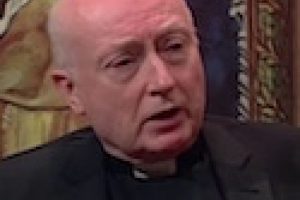Column: From the Pastor
I knew an elderly Scotswoman who read the Bible each night by the light of a candle. It had become a kind of ritual, for everyone needs a rite, including those reared in the stark Calvinist kind of worship of her homeland Kirk. While she did all of her other reading by electric light, the lamp was turned off and the candle lit for the Bible. It was by that burning taper that she could read, as all of us can, the wonderful and mysterious words: “I am the light of the world. Whoever follows me will not walk in darkness, but will have the light of life” (John 8:12).
That contrast of light and dark is powerfully depicted in the Isenheim Altarpiece now in Colmar, France. It was produced between 1512 and 1516 by the sculptor Nikolaus of Haguenau and painter Matthias Grünewald for a hospital that treated people suffering from skin diseases, and such affliction is depicted on the flesh of the Crucified Christ in what has been called “The most beautiful painting of ugliness in the history of art.”
In the scene, the darkness of the Passion is darker for being next to the incandescent light of the Risen Christ. At the foot of the Cross, in deliberate contempt for chronology, is John the Baptist, still alive and attended by a lamb, for John had called his cousin “the Lamb of God, who takes away the sins of the world” (John 1:29). The Lamb, a symbol of Christ sacrificed on the cross, is also the Light that pre-existed all created light as we know it.
“And the city has no need for sun or moon to shine on it, because the glory of God illuminates the city, and the Lamb is its lamp” (Revelation 21:23).
That illuminating “glory of God” briefly broke through created light as we know it in the Transfiguration. If it is to be understood to some small degree, that will be by acknowledging the “pre-existence” of Christ: “He was in the beginning with God. All things came into being through him, and without him not one thing came into being” (John 1:2-3).
Even in speech, the mystery of Christ’s pre-existence declares itself: “. . . before Abraham was, I am” (John 8:58). For any human confined to chronology, saying these words would be using bad grammar. One might say “I was” (Simple Past), “I was existing” (Past Continuous), “I had existed” (Past Perfect), or “I had been existing” (Past Perfect Continuous), but only Christ can defy grammar by saying that before Abraham was, “I am.”
John, standing at the Jordan River, poorly dressed and even more poorly fed, employed the only grammar available to him to declare of his younger cousin: “This is he, of whom I said: After me there comes a man who is preferred before me, because he was before me” (John 1:30).
——————
Fr. George W. Rutler, S.T.D., is a brilliant scholar, author, convert, former pastor of Our Saviour in Midtown Manhattan, the closest Catholic parish near the site of 9-11, and now pastor of St Michael’s parish in Hell’s Kitchen, New York City. A donation of any amount may be made to the parish at: www.StMichaelNYC.com
View Articles Father Rutler was ordained to the diaconate in Rome by His Eminence William Cardinal Baum in 1980 and received priestly ordination in St. Patrick's... MORE »



You must be logged in to post a comment.